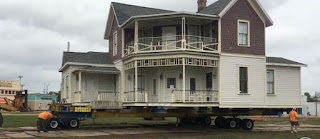 |
| Dr. Josie Rogers |
I recently read the excellent The Doctors Blackwell bio. The book made me think about Dr. Josie Rogers (1876-1975). She's locally famous in my area but otherwise little known.
Every city or county in the country probably has their version of a Dr. Rogers. Locally known but otherwise obscure. Such a shame. They likely were fascinating people.
I was familiar with Dr. Elizabeth Blackwell because I read a YA biography of her when I was a pre-teen. Until I read the 2021 biography I didn't realize her sister, Emily, was also a pioneering woman doctor.
The legacy of both Blackwells has been overshadowed. They didn't fit into the narratives controlled by contemporaries who promoted their own agendas. The Blackwell sisters not only faced discrimination from men. At times they were pushed aside by other women. Those others shaped written history - at least the history I learned.
That made me wonder where Dr. Rogers fit into narrative of her time. She was born in Daytona Beach the same year the town became a city - 1876. Her family was educated and fairly well-off, but they were still pioneers. In Dr. Rogers' short reminiscences of the city's early years, she wrote about wild animals prowling on the porch in search of food.
The anecdote contains wonderful details. The cupboard was made of red cedar and had a mahogany top. Wire screening enclosed the cupboard on three sides. "Mother said she often heard wild cats scratching at the wire..." Dr. Rogers wrote in In Retrospect - Daytona and the Early Years.
The 26-page booklet doesn't list a publisher or a publishing year. It does note Dr. Rogers wrote her memories in 1948. So, she was in her early 70s when she looked back.
By that time, Dr. Rogers had a string of accomplishments to her credit. The unsigned introductory page of Retrospect lists them. There are too many to recount here.
Dr. Rogers earned her M.D. degree in 1907 in Chicago. She practiced in and around Daytona Beach for close to 50 years. Her career included stints as school physician and a county doctor for the Florida state board of health. She was chief of staff at what was then called Halifax District Hospital in 1947.
She also served as a city commissioner and was elected Daytona Beach's first woman mayor in 1922. Add in the many community and civic organizations she either pioneered or supported and you have an amazing life. But I don't know much about the person herself.
She came from a family of achievers. That's obvious. Her sister became a college professor, her older brother an engineer, and her younger brother a land developer. The introduction to her reminiscences describes her as "devoted to her family" and "a wise counsellor and staunch friend with a keen mind and sharp wit."
Tight family bonds are evident in her stories of the past. She loved to visit her grandparents, who also lived in Daytona Beach. She got along well with her siblings and didn't cause any trouble to her parents. Extended family members were a close and welcome part of her life.
Her attention to detail is everywhere. She recalled the overland leg of the trip home after visiting relatives in her parents' native New Jersey. This was before the railroad reached Daytona, so she was still pretty young.
Her mother, grandmother, aunt, and she and her siblings traveled from St. Augustine to Daytona in a wagon. They all rode in the back, seated on hay. The driver got lost, which caused a great deal of worry among the adult women.
Dr. Rogers remembered waking up in the middle of the night to hear the women whispering. The driver had stopped at a house. A stranger emerged, got on a mule, and started leading the wagon through the woods. Dr. Rogers says the adults feared for their lives. But the stranger turned out to be simply a guide.
As dawn broke, they were halfway to Daytona and stopped at a cabin that had a swept yard. "To this day, when I smell chicory coffee it brings back memories of that meal when the grits and fried salt pork with corn pone tasted delicious to us hungry travelers," she wrote. "Father was greatly worried by our delay and was making arrangements to search for us when we arrived (home)."
She recalled often receiving books and reading magazines. She was one of the young readers who waited for each new book from Louisa May Alcott. She received them "as fast as they were published."
Interestingly, a book Dr. Rogers mentioned was Eminent Women of the Ages. One of the women profiled in it was a cousin of her great-grandmother. That distant relative, Clemence Lozier, was one of the first women doctors in New York City.
Dr. Rogers never married. Neither did her sister. Dr. Rogers' reminiscences include anecdotes about a few local women who lived independent lives. I could speculate they provided models of options available for women. But she had equally influential models of women who chose traditional roles.
She wrote engagingly of people and places, pioneer experiences, community life, and her childhood self. What she didn't write about were her teenage years, her schooling, or her adult self. Perhaps she did. Maybe they're part of her unpublished papers. Just waiting for a biographer.
More information about Dr. Rogers shows up on genealogy websites including Find A Grave and a family genealogy website. The Rogers family home, built in 1878, still stands in Daytona Beach. Read its 1986 nomination for the National Register of Historic Places.
 |
| Dr. Rogers lived, worked, and died in the historic family home, now owned by the city of Daytona Beach. For restoration reasons, the city had the house moved a short distance, as this 2020 video shows. |
